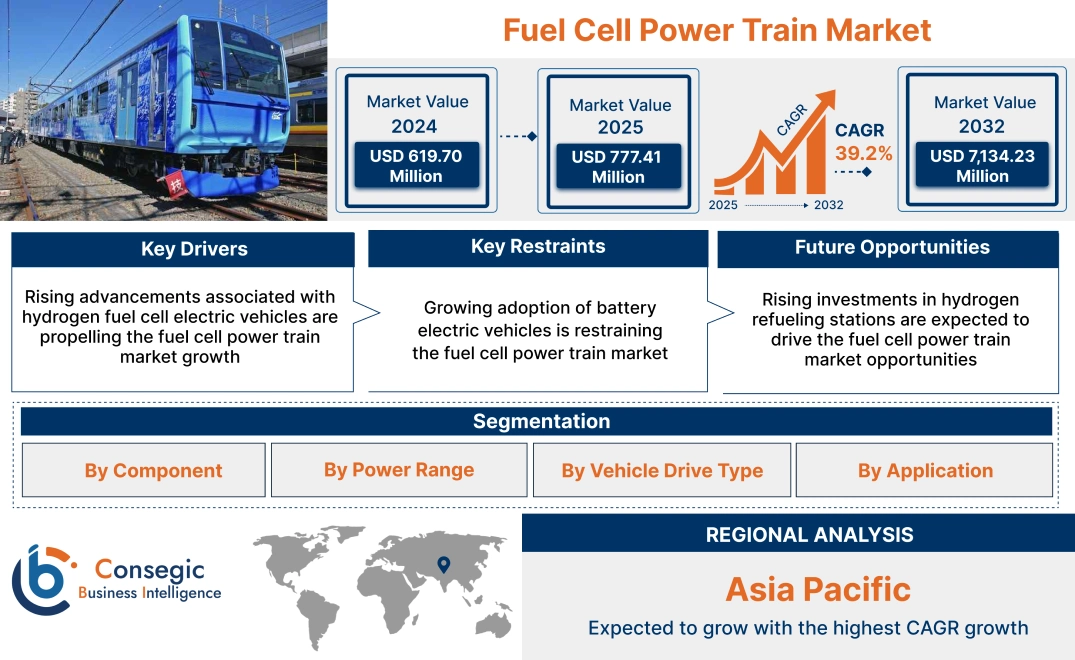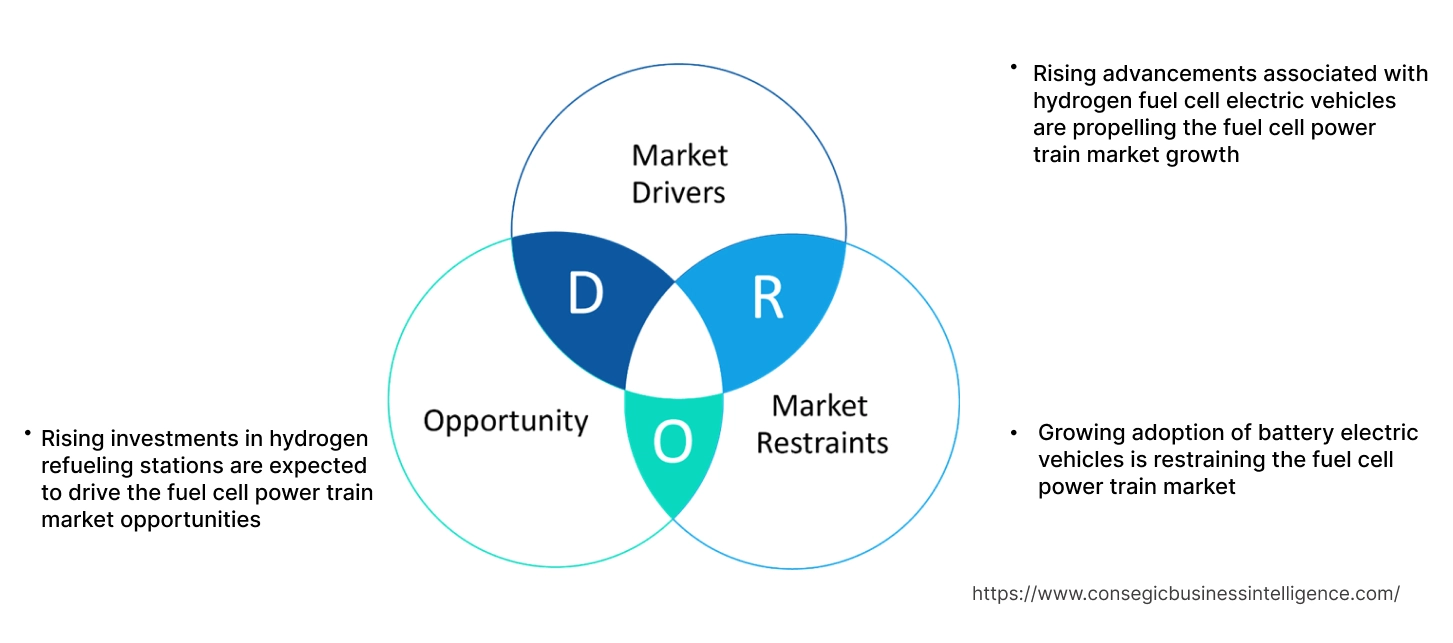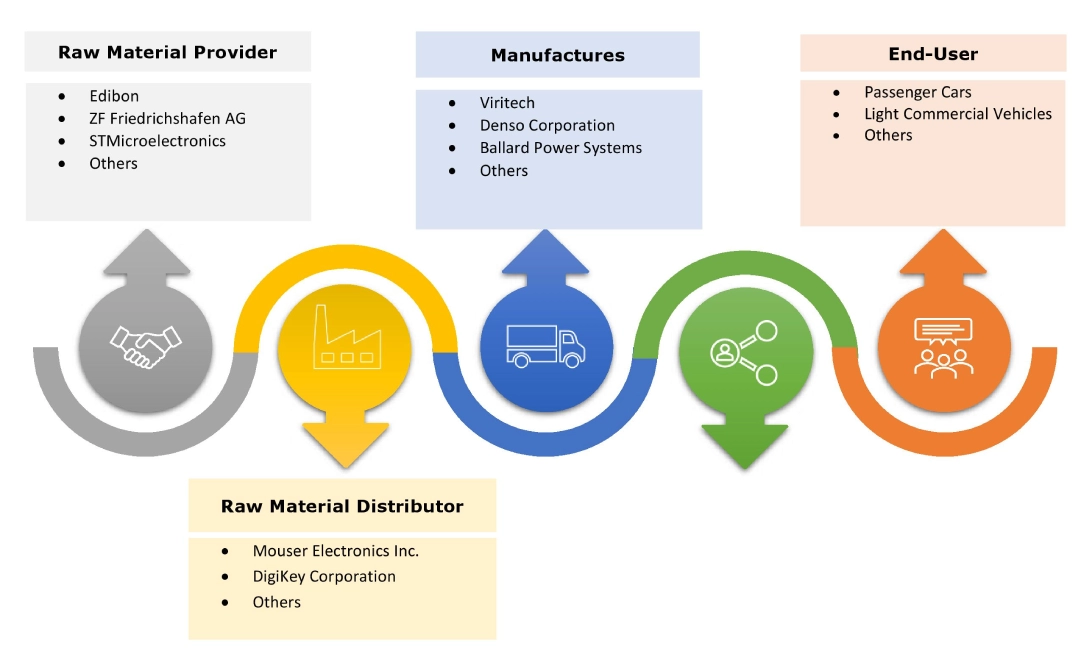- Summary
- Table Of Content
- Methodology
Fuel Cell Power Train Market Scope & Overview:
A fuel cell power train refers to a system that utilizes fuel cells to convert chemical energy, typically from hydrogen, into electrical energy to power vehicles or other types of machinery. The fuel cell typically generates electricity through an electrochemical reaction between hydrogen and oxygen, with water and heat as the only byproducts.
This electricity is then used to drive electric motors, which provides propulsion for the vehicles. Moreover, fuel cell powertrains provide a range of benefits such as zero emissions, high efficiency, longer driving range, excellent torque and power delivery, low noise operations, and others.
Fuel Cell Power Train Market Size:
Fuel Cell Power Train Market size is estimated to reach over USD 7,134.23 Million by 2032 from a value of USD 619.70 Million in 2024 and is projected to grow by USD 777.41 Million in 2025, growing at a CAGR of 39.2% from 2025 to 2032.
Key Drivers:
Rising advancements associated with hydrogen fuel cell electric vehicles are propelling the fuel cell power train market growth
Fuel cell power train is a crucial component in hydrogen fuel cell electric vehicles (FCEVs), enabling them to convert hydrogen into electricity to power vehicle propulsion. Moreover, several governments worldwide are implementing stringent emissions regulations and providing incentives for cleaner transportation options.
Fuel cell electric vehicles offer a zero-emission solution, which aligns with global efforts to combat climate change. As a result, the rising advancements associated with hydrogen fuel cell electric vehicles are driving the market.
- For instance, in March 2022, the Indian Ministry of Road Transport and Highways launched an exclusive pilot project for hydrogen-based advanced fuel cell electric vehicles (FCEVs), demonstrating a major shift from fossil fuels to sustainable transportation for environmental protection.
Therefore, the rising advancements associated with hydrogen fuel cell electric vehicles are increasing the adoption of fuel cell powertrain, in turn proliferating the fuel cell power train market size.
Key Restraints:
Growing adoption of battery electric vehicles is restraining the fuel cell power train market
The growing adoption of battery electric vehicles (BEVs) is among the primary factors influencing restricting the market demand for fuel cell power train. BEVs benefit from the rapidly expanding network of electric vehicle charging stations, which are easier and cost-effective to establish as compared to hydrogen refueling stations.
Moreover, fuel cell electric vehicles (FCEVs) typically involve higher initial costs in comparison to BEVs, primarily due to the complexities of fuel cell manufacturing and hydrogen storage systems.Additionally, hydrogen refueling stations are still relatively lower as compared to EV charging stations. The above factors are further driving the adoption of battery electric vehicles. Hence, the rising consumer preference and adoption of BEVs due to their ease of access to charging and cost-efficiency, is hindering the fuel cell power train market expansion.
Future Opportunities :
Rising investments in hydrogen refueling stations are expected to drive the fuel cell power train market opportunities
The rising investments in hydrogen refueling stations are creating significant opportunities for the fuel cell powertrain market. The increasing investment in development of hydrogen refueling stations increases the convenience of refueling FCEVs. The availability of refueling stations facilitates the consumer shift towards purchasing FCEVs, in turn boosting market demand for fuel cell powertrain system.
- For instance, in December 2024, the California Energy Commission (CEC) approved an investment of USD 1.4 billion for accelerating the progress on the state’s EV charging and hydrogen refueling stations. The investment aims at deploying hydrogen refueling and EV charging infrastructure for light, medium, and heavy-duty zero-emission vehicles across California over the next four years.
Hence, as per the analysis, the investments in hydrogen refueling stations is projected to boost the fuel cell power train market opportunities during the forecast period.
Top Key Players and Market Share Insights:
The global fuel cell power train market is highly competitive with major players providing services to the national and international markets. Key players are adopting several strategies in research and development (R&D), product innovation, and end-user launches to hold a strong position in the fuel cell power train market. Key players in the fuel cell power train industry include-
- Viritech (United Kingdom)
- Denso Corporation (Japan)
- Infineon Technologies AG (Germany)
- FEV Europe GmbH (Germany)
- Continental Engineering Services (Germany)
- Ballard Power Systems (Canada)
- Ceres Power (UK)
- MAHLE Powertrain Ltd (United Kingdom)
- Cummins Inc. (US)
- Robert Bosch GmbH (Germany)
Fuel Cell Power Train Market Segmental Analysis :
By Component:
Based on component, the market is segmented into fuel cell system, drive system, battery system, hydrogen storage system, converters, and others.
Trends in the component:
- Increasing adoption of fuel cell system due to its several benefits including zero emissions, high efficiency, and rapid refuelling among others.
- There is a rising trend towards utilization of hydrogen storage system, attributing to its compact design, scalability, and safe and reliable storage.
Fuel cell system segment accounted for the largest revenue share in the total fuel cell power train market share in 2024, and it is anticipated to register fastest CAGR growth during the forecast period.
- Fuel cell system is a primary component of the fuel cell powertrain, which is responsible for converting hydrogen into electricity to power electric vehicles (FCEVs) or other applications.
- Moreover, fuel cell system operates through an electrochemical reaction and consists of several components that manage the supply of hydrogen and air, manage power generation, handle energy distribution, and ensure efficient vehicle operation.
- For instance, in May 2024, Cellcentric GmbH launched its NextGen model of fuel cell system that is specifically designed for application in long-haul trucks. The fuel cell system features a compact design and a net output of over 350 kW.
- According to the analysis, the rising advancements associated with fuel cell system are driving the market.
By Power Range:
Based on power range, the market is segmented into less than 150 KW, 150–250 KW, and more than 250 KW.
Trends in the power range:
- Increasing adoption of fuel cell system with less than 150 KW power range due to its lightweight, compact design, and improved cost-efficiency.
- There is a rising trend towards utilization of fuel cell systems with power range over 250 KW, attributing to its longer range and high performance.
Less than 150 KW segment accounted for the largest revenue share of 40.05% in the overall market in 2024.
- Fuel cell powertrain systems with power output less than 150 KW are primarily suitable for light-duty applications, including passenger vehicles and certain light-duty commercial vehicles.
- Moreover, these systems offer several benefits including lightweight, compact design, cost-efficiency, and optimized vehicle performance.
- For instance, in December 2022, Symbio introduced its new fuel cell StackPack systems that are designed to meet the requirements of all mobility applications. The fuel cell system covers a large power range starting from 40kW.
- According to the fuel cell power train market analysis, the rising advancements associated with fuel cell systems with power range below 150 KW are driving the fuel cell power train market growth.
More than 250 KW segment is anticipated to register a substantial CAGR growth during the forecast period.
- Fuel cell powertrain system with power range over 250 KW refer to high-power systems that are designed for heavy-duty applications and larger commercial vehicles.
- Moreover, these systems are capable of providing high torque and power for demanding performance requirements.
- Additionally, these systems provide longer drive range, significant power and torque delivery, and high performance.
- For instance, Viritech is a fuel cell powertrain manufacturer that offers 360kW fuel cell/640kW deployable single fuel cell powertrain in its product offerings. The system is particularly designed for application in heavy good vehicles.
- Hence, the increasing advancements related to fuel cell systems with power range over 250 kW are anticipated to boost the fuel cell power train market size during the forecast period.
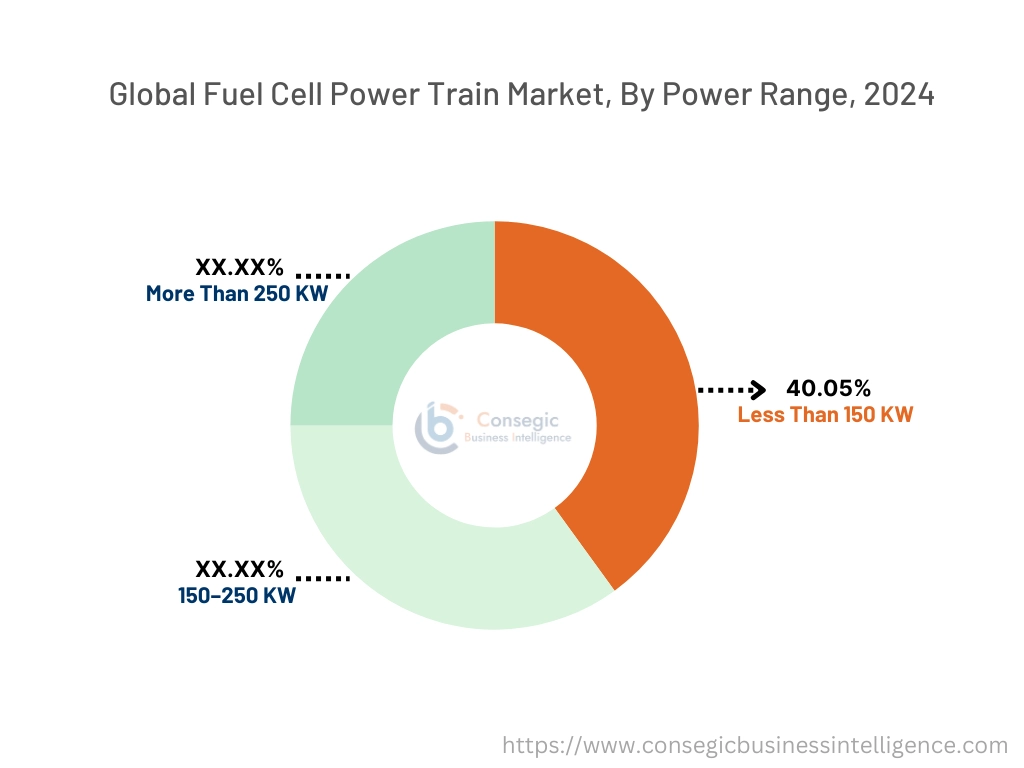
By Vehicle Drive Type:
Based on vehicle drive type, the market is segmented into front wheel drive (FWD), rear wheel drive (RWD), and all-wheel drive (AWD).
Trends in the vehicle drive type:
- Increasing adoption of all-wheel drive vehicles, attributing to its enhanced traction, improved off-road capability, increased stability, and others.
- Rising advancements in rear wheel drive vehicles for enhanced acceleration performance, improved handling and stability.
All-wheel drive (AWD) segment accounted for a significant revenue in the overall fuel cell power train market share in 2024, and it is anticipated to register a substantial CAGR growth during the forecast period.
- All-wheel drive vehicles are designed to distribute power to all four wheels simultaneously, which enhances the vehicle traction and stability on a variety of surfaces.
- AWD systems automatically manage the distribution of power to the front and rear wheels, which helps improve handling, particularly in adverse conditions such as rain, snow, or off-road environments.
- Additionally, the integration of fuel cell powertrain system in AWD vehicles offers numerous benefits including immediate power delivery, enhanced performance in varying conditions, zero emissions, reduced carbon footprint, and others.
- For instance, Lexus Plc introduced Lexus LF-FC fuel cell vehicle concept, which is powered by a high-output fuel cell and all-wheel drive system while including both gesture control and automated driving technologies.
- Therefore, increasing advancements related to fuel cell vehicles integrated with all-wheel drive system are driving the fuel cell power train market trends.
By Application:
Based on the application, the market is segmented into passenger cars, light commercial vehicle (LCV), buses, trucks, and others.
Trends in the application:
- Factors including the rising disposable income, growing popularity of luxury cars, and progressions in autonomous driving systems are among the primary factors driving the passenger cars segment.
- Increasing advancements associated with fuel cell buses, attributing to its zero emissions, eco-friendliness, and sustainability.
Passenger cars segment accounted for the largest revenue share in the total market in 2024.
- Passenger cars refer to multi-track vehicle with at least two axles, intended for the carriage of passengers and designed to seat maximum nine individuals including the driver.
- Fuel cell powertrain system are typically used in fuel cell electric vehicles, including passenger cars. This system converts hydrogen fuel into electrical energy, which powers electric motors to propel the vehicle.
- For instance, in September 2024, BMW Group announced collaboration with Toyota Motor Corporation, with the aim of providing fuel cell electric vehicle (FCEV) options for passenger cars.
- According to the analysis, the rising advancements associated with passenger vehicles with FCEV options are driving the fuel cell power train market.
Buses segment is anticipated to register a significant CAGR during the forecast period.
- Fuel cell powertrain system is used in fuel cell buses that utilize hydrogen fuel cells to convert chemical energy from hydrogen into electrical energy, which powers electric motors to drive the bus. This offers a clean alternative to diesel-powered or battery electric buses, contributing to lower emissions and sustainable public transportation.
- Factors including increasing need for economical modes of transportation and growing advancements in commercial buses are primary factors driving the growth of the segment.
- For instance, in September 2023, Tata Motors, a commercial vehicle manufacturer, launched its first hydrogen fuel cell powered buses to Indian Oil Corporation Ltd. (IOCL), marking the company’s commitment towards greener and sustainable mobility solutions.
- Therefore, the increasing development of hydrogen fuel cell powered buses is expected to propel the market during the forecast period.
Fuel Cell Power Train Market Report Insights :
| Report Attributes | Report Details |
| Study Timeline | 2019-2032 |
| Market Size in 2032 | USD 7,134.23 Million |
| CAGR (2025-2032) | 39.2% |
| By Component |
|
| By Power Range |
|
| By Vehicle Drive Type |
|
| By Application |
|
| By Region |
|
| Key Players |
|
| North America | U.S. Canada Mexico |
| Europe | U.K. Germany France Spain Italy Russia Benelux Rest of Europe |
| APAC | China South Korea Japan India Australia ASEAN Rest of Asia-Pacific |
| Middle East and Africa | GCC Turkey South Africa Rest of MEA |
| LATAM | Brazil Argentina Chile Rest of LATAM |
| Report Coverage |
|
Regional Analysis:
The regions covered are North America, Europe, Asia Pacific, the Middle East and Africa, and Latin America.
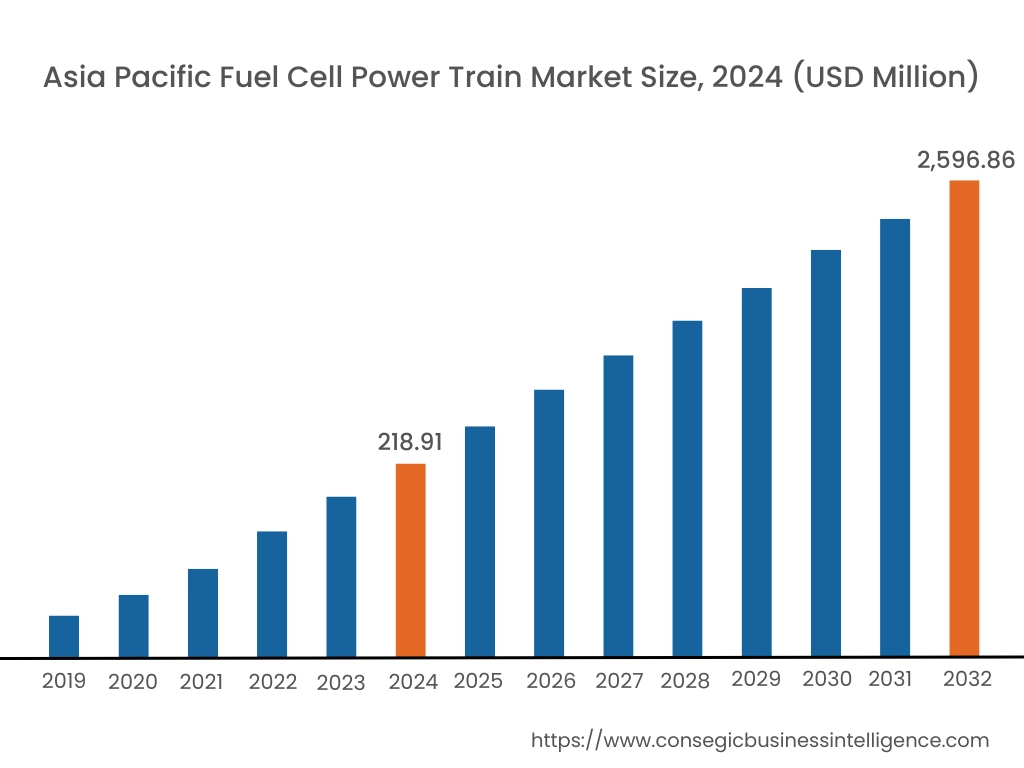
Asia Pacific region was valued at USD 218.91 Million in 2024. Moreover, it is projected to grow by USD 275.31 Million in 2025 and reach over USD 2,596.86 Million by 2032. Out of this, China accounted for the maximum revenue share of 35.2%. As per the fuel cell power train market analysis, the adoption of fuel cell powertrain in the Asia-Pacific region is primarily driven by the increasing demand for eco-friendly and sustainable transport solutions and rising investments in fuel cell vehicles among others. Additionally, the rising production of hydrogen fuel cell powered vehicles is further accelerating the fuel cell power train market expansion.
- For instance, Hyundai Motor Company, a South Korean automobile manufacturer, launched its new NEXO Fuel Cell series of hydrogen powered SUVs. The fuel cell vehicle provides a driving range up to 380 miles. The above factors are driving the adoption of fuel cell powertrain system, in turn propelling the market in the Asia-Pacific region.
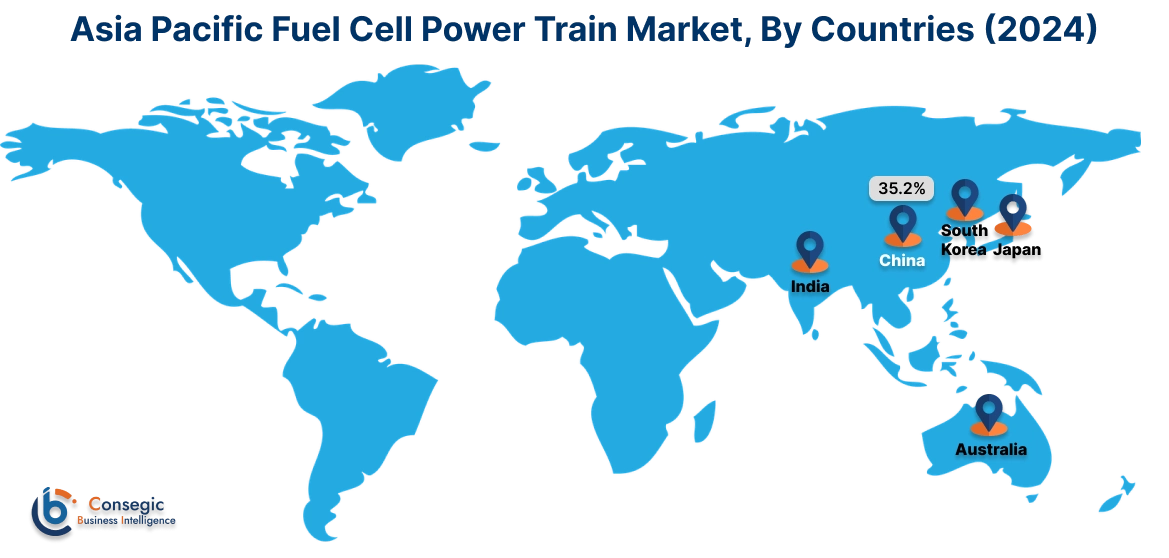
North America is estimated to reach over USD 2,061.08 Million by 2032 from a value of USD 179.08 Million in 2024 and is projected to grow by USD 224.65 Million in 2025. In North America, the growth of fuel cell power train industry is driven by the growing investments in greener transportation industry and rising vehicle production among others. Similarly, the rising development of hydrogen refueling stations are contributing to the fuel cell power train market demand.
- For instance, in January 2024, the S government announced a funding of approximately USD 623 million for the development of hydrogen refueling infrastructure and EV charging network across the United States. The funding will provision projects in Colorado, Texas, and California, which will deploy clean hydrogen fueling stations for medium and heavy-duty vehicles. The rising investments in hydrogen refueling stations is projected to increase the adoption of fuel cell vehicles, thereby, driving the fuel cell power train market trends in North America during the forecast period.
The regional analysis depicts that prevalence of favorable government measures and initiatives for eco-friendly mobility solutions and rising production of fuel cell vehicles are driving the fuel cell power train market demand in Europe. Furthermore, as per the market analysis, the market demand in Latin America, Middle East, and African regions is expected to grow at a considerable rate due to factors such as growing advancements in hydrogen fuel cell technology and increasing investments in fuel cell powered vehicles among others.
Recent Industry Developments :
Product Launch:
- In May 2024, Viritech launched its new VPT60N model of fuel cell powertrain, which is particularly designed for cars, light commercial vehicles, and off-highway applications. It is highly configurable and features modular design that enables easy integration across numerous applications.
Partnerships & Collaborations:
- In August 2024, Nuvera Fuel Cells LLC partnered with Viritech Limited, with the aim of exploring the possibility of deploying and supporting Viritech’s VPT60N model of powertrain for commercial vehicles. Nuvera will be supplying its E-series of fuel cell engines for testing of integration with the powertrain product line from Viritech along with providing technical support during the integration and operational testing.
Key Questions Answered in the Report
How big is the fuel cell power train market? +
The fuel cell power train market was valued at USD 619.70 Million in 2024 and is projected to grow to USD 7,134.23 Million by 2032.
Which is the fastest-growing region in the fuel cell power train market? +
Asia-Pacific is the region experiencing the most rapid growth in the fuel cell power train market.
What specific segmentation details are covered in the fuel cell power trains report? +
The fuel cell power trains report includes specific segmentation details for component, power range, vehicle drive type, application, and region.
Who are the major players in the fuel cell power train market? +
The key participants in the fuel cell power train market are Viritech (United Kingdom), Denso Corporation (Japan), Ballard Power Systems (Canada), Ceres Power (UK), MAHLE Powertrain Ltd (United Kingdom), Cummins Inc. (US), Robert Bosch GmbH (Germany), Infineon Technologies AG (Germany), FEV Europe GmbH (Germany), and Continental Engineering Services (Germany).
